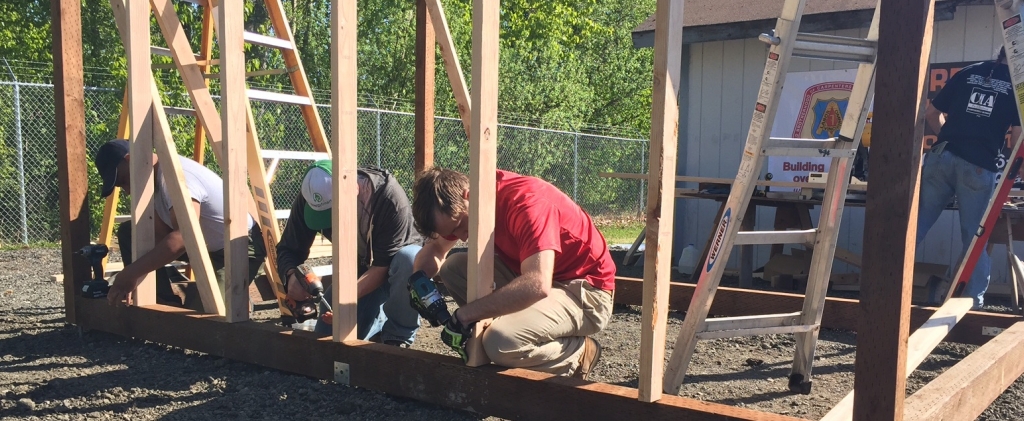More Than a Greenhouse: Building a Food Independent Alaska
O
n May 14th, a particularly brisk and sunny morning, a diverse group of laborers and volunteers convened in Anchorage, Alaska. Their skill sets and backgrounds varied widely: there were designers from McCool Carlson Green Architects, artisans from the Northwest Pacific Regional Council of Carpenters, Cities of Service Resilience AmeriCorps VISTA members, and residents. Despite their differences, the group members were indistinguishable from one another as they prepared for the day, arming themselves with tool belts, cordless drills, and leather gloves. The team also shared the same passion, and the same goal: to bolster Alaska’s food independence by building a greenhouse for a local school.
The Alaskan food economy is complex. In-state agriculture supplies only five percent of the state’s food needs; 95 percent is imported. $1.9 billion a year is removed from the local economy and is spent on importing food. One in five Alaskan children is food insecure, and 65 percent of people in the state are obese. According to the Alaska Farm Bureau, if outside food sources were cut off, Alaska would only have a three to five day food supply in-state. As weather becomes less predictable, and fuel prices rise, these statistics and reliance on imports paint a concerning picture of the future.
Across the state, Alaskans are combating these challenges by working toward food independence. Communities that have achieved food independence rely on local food that does not need to be imported. In the small, Northwest Arctic town of Kotzebue, Alaska, residents have cultivated many village and community gardens in an effort to feed themselves without imported food. At one point, the tiny town was home to over 600 community gardens. In Bethel, Alaska, approximately 400 miles west of Anchorage, the city installed infrastructure that supports small-time local farmers, such as metal piping to withdraw heat from permafrost. Community gardens in the town are available for all citizens. A curriculum surrounding food, including nutrition, growing, and cooking, was incorporated into Bethel’s schools and extracurricular programs.
The greenhouse in Anchorage is part of this state-wide movement. It will be used to cultivate food and will be part of an immersive program. It was built for the Mountain View Elementary School 21st Century Afterschool Program, where it will be a teaching tool for local students, providing a nutritional education, knowledge of food independence, and hands-on growing experience. The resilience-specific curriculum was designed in partnership with the Cooperative Extension Office at the University of Alaska Fairbanks and the Junior Master Gardeners Program, which is affiliated with the Alaska Botanical Gardens. The curriculum will emphasize the relevance of the program for students and encourage them to get their families involved.
As the work day drew to a close, Jared James and Cas Newman, Cities of Service Resilience AmeriCorps VISTA members, proudly observed as the greenhouse structure became recognizable. The project was Jared’s idea, and he and Cas had worked tirelessly with several partners handling programmatic logistics. Where would the volunteers come from? Cas got word out about the project in the community and coordinated with volunteers. Where would the supplies come from? Prior to construction, Jared and Cas contacted local construction stores in Anchorage, and managed to connect with Spenard Builders Supply Company for the provision of tools. Would the structure be sturdy enough to stand against strong, Alaskan earthquakes? Jared worked with McCool Carlson Green Architects to review the structural blueprints and ensure that the structure would be sound. Who would help design the curriculum? Jared contacted the curriculum designers himself and worked to create an educational connection to growing food. The preparation and the building was a team effort requiring cross-sector collaboration from the Municipality of Anchorage, citizens, local businesses, and volunteers. After eight hours of work, as dusk approached, Jared and Cas stepped back and admired the team’s work. Their collective feeling of success and pride was not just about the greenhouse. The greenhouse itself lays the foundation for educating local students and creating a stronger, more resilient Anchorage.
Further Reading on Alaskan Food Independence
Alaska Food Policy Council Website
Building Food Security in Alaska | Ken Meter and Megan Phillips Goldberg, July 28, 2014
Food in the Last Frontier: Inside Alaska’s Food Security Challenges and Opportunities | Elizabeth Hodges Snyder and Ken Meter, June 2015
In the Last Frontier, Local Food is More Than a Luxury | Steve Holt, November 13, 2014
Outpost Gardening in Interior Alaska: Food System Innovation and the Alaska Native Gardens of the 1930s through the 1970s | Philip A. Loring and S. Crain Gerlach, 2010

